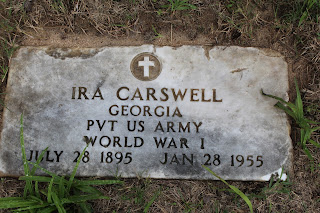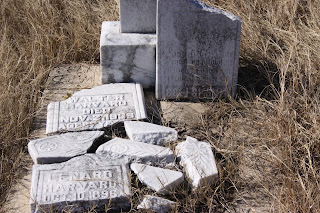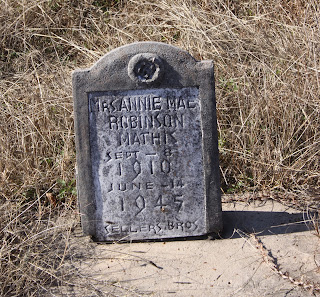THE LOST SOULS ’CROSS THE CREEK
This a place where for nearly a half of a century these forgotten souls were lost. Left to spend eternity alone, these banished people have rested in peaceful obscurity in a broom straw field, secluded behind a water treatment plant, on the ridge of the swamp of Hunger and Hardship Creek. This weekend, the people of the City of Dublin will come together to recognize these nearly fifteen hundred departed persons and welcome them to their new and improved eternal resting place, which folks around here have been calling “’Cross The Creek” for more than a century now.
In the latter quarter of the 19th Century, few African Americans lived within the city limits of Dublin. Most lived out in the county. It wasn’t until 1895 when the City of Dublin purchased a tract of land on North Decatur Street from Mary Wolfe for a cemetery for African American residents in the neighborhood they still call Scottsville.
Within a decade, the Scottsville Cemetery, located across the street from the Second African Baptist Church, was deemed as too full to continue burials. The city council agreed and began to seek out a new location for a cemetery.
Some strong resistance came from the citizens of the area north and west of the Scottsville neighborhood, proclaiming that if you (the city and its black residents) want a cemetery in this area, you are going to have to go across the creek. The name stuck. It is still with us today.
The City of Dublin, in 1906, bought a tract from T.B. Hudson, some twenty-one acres, for the sum of $ 1576.00, a price slightly higher than the city had paid for Northview Cemetery some three years earlier.
By the end of 1906, the council required that all persons wishing to have loved ones buried in the cemetery obtain a permit from the city first.
Every five to ten years, there would be cries for help to clean up the unsightly and overgrown conditions. Broken tombstones, collapsed slabs and vanished markers made any type of identification of those persons buried here virtually impossible.
Historian and former Laurens County Historical Society President Allen Thomas was among the first to bring the plight of the abandoned cemetery to light. Thomas, looking at the overgrown six-acre site in 1994, observed the number of marked graves and estimated that 300 to 400 graves were located on the grounds.
The cemetery itself may have never been saved without the efforts of Jimmy Sawyer, a city superintendent, who began working voluntarily there as a teenager in the 1960s. Sawyer cleared a virtual jungle of trees, briars and brambles to keep the area in a maintainable condition.
Then came the late Vernon Alligood, a member of the Laurens County Historical Society’s Cemetery Committee, who was the first to compile a list of the marked graves here. With many of the marked graves having no readable inscription or no inscription at all, Alligood’s list was far from complete.
The missing key to the list of persons buried in ’Cross The Creek Cemetery was discovered just two years ago. When City Cemetery Sexton Billy Mason was overseeing the renovations to Northview Cemetery on the other side of the creek, a small collection of brown paper covered books, printed with the words “Negro Cemetery” were discovered in the rear of a drawer of a desk bound for the dumpster.
The neatly compiled book contained the records of burials in the cemetery with names, dates of internment and the funeral home conducting the burials from 1927 to 1945.
Enter Billy and Loree Beacham, the leading local contributors to the “Find-a-Grave” project in the country.
“I love genealogy. I know some of my friends think I am weird, since I enjoy visiting cemeteries. Those buried in cemeteries walked and lived as we do today. They must not be forgotten,” proclaims Loree, who has posted nearly 55,000 burials in the Central Georgia area.
Billy, her husband, gets in on the act too, taking more than 77,000 usable photographs of grave markers and cemeteries.
With Mason’s treasured list in hand, the Beachams set out to locate as many known burials as they can. Using Internet resources, including death certificates and the newly indexed issues of the Dublin Courier Herald available on at the Laurens County Library and the Dublin Laurens Museum, Billy and Loree have now documented 839 known burials in this hallowed ground.
Missing from the cemetery lists are burials from 1906 through 1926 and from the period from 1945 until Clara Page was the last known burial in November 1965, fifty years ago. During that third of a century gap when no records exist, the actual number of burials could easily top 1500 or more, creating a difficult challenge to the determined duo to accomplish their goal of identifying as many graves as they can.
Without the establishment of a private cemetery by Dublin businessmen and funeral home owners, C.D. and H.H. Dudley, the number of burials would be substantially more and the need for expansion would have been necessary many decades ago.
In 1932, when the Dudleys sought to establish a cemetery on his land at the head of North Washington and North Decatur Streets along East Mary Street, 77 residents of the Mary Street area and Scottsville neighborhood protested the establishment of a private cemetery in their neighborhood.
At first, the city and Dudley were restrained by a local judge from any more burials. The court, in a complete reversal of its own order, allowed burials to commence by stating in essence, “Even the “darkies” of Dublin should not have to go ‘cross the creek to bury their dead.”
Beneath these sunken holes and weathered tombstones lie the mortal remains of fathers, mothers, and sadly way too many children. There are masons, brick and the Free and Accepted ones too. At least fourteen ministers of the Gospel left their mortal remains were on their way to Heaven.
They are the women who cooked our food, cleaned our houses and performed tasks that no one else could or would do. They are the men who built our buildings, shined our shoes and taught our children. There are seven men, so far as we know, who served our country in World Wars I and II.
Thank you, Albert Coleman, 517th Engineers, U.S. Army; Fred Daniels, U.S. Army; Clarence Gilmore, 3 Bordeaux Gas Co., U.S. Army, World War I; Cleveland Poole, U.S. Army; Fred D. Bailey 3822 QM Trucking Co., U.S. Army, WWII; Winfield Dell, Pvt. 10th Engineers, WWI; Morris Stanley, STM 1C, U.S. Navy, WWII; and Ira Carswell, U.S. Army, WWI for serving our country. And, a thank you to all of those who served and we don’t yet know your names.

Here lie the bodies of Annie E. Hurst and St. Clair McCormick Shurney. You don’t know their names. But you do know Hurst’s grandson, six-time World Boxing Champion Sugar Ray Robinson, who grew up in Dublin and stood by her grave in 1948. Mrs. Shurney died when her son was a small boy. Without the benefit of high school diploma, Robert Shurney obtained a degree in physics from Tennessee State University as a prelude to his work as a N.A.S.A. physicist. Dr. Shurney worked on balancing the Saturn V moon rockets, training astronauts in a simulated weightless environment, designed the tires for the Apollo lunar rovers, better methods of eating in space and the first permanent bathroom in a space craft.
Katie Dudley and Clayton Dudley once lied here too, . They were the matriarch and patriarch of the Dudley family. There bodies were moved the family plot in the cemetery on the other side of the creek which bears their name.
Based on the information available, there are at least 50 persons in this graveyard who toiled in the hot, dirty fields and massive plantation houses as slaves. Emma Webster and Amanda Miller were children of one when they gained their freedom. (See below for a current list)
Here is a great big hallelujah to William Horne, who was 55 years old when the Civil War ended and was buried here in 1925 at the reported age of 115. And to Ms. Lucy Davis, a native of North Carolina and the oldest known woman to lie here. She was 104 years young when she went to see her Lord. And to Dicey McCall, who topped the century mark a year before her death in 1924.
And, to sweet little Margaret Price, whose death broke her parent’s hearts seven months after her birth. Our tears go out to the families of the the hundreds of infants who never knew what living was.
And, finally to M.H. Hall, a man who died as he lived - a Christian.
And so it will be on this day, Sunday, November 1, 2015, that the lost, once banished souls of ‘Cross The Creek will come home now and forever.
KNOWN AFRICAN AMERICAN SLAVES BURIED IN
ACROSS THE CREEK CEMETERY
William Horne - 1810-1925 (115 years old at death)
Lucy Davis - 1818 - 1922 (104 years old at death)
Dicey McCall - 1823 - 1924 (101 years old at death)
Boston Dixon - 1835 -1925
Bobbie Ann Harris - 1838- 1938
Thomas Williams - 1838 - 1925
Nicey Bess - 1840 - 1923
Melvin Ashley - 1840 - 1926
Reuben Fordham - 1841 - 1937
Louise Grubbs - 1841 - 1924
Love Reinhardt - 1845 - 1926
William Hunter - 1845 - 1930
Monroe Pilcher - 1848 - 1936
Lawrence West - 1848 - 1925
Margaret Yopp - 1848 - 1938
Mose Jones - 1849 - 1924
Casesar Brown - 1850 - 1936
Laura Williams - 1851 - 1926
Frank Yopp - 1851 - 1921
Lydia Hester - 1852 - 1922
Emma Alexander - 1853-1914
Calvin Knight - 1852 - 1927
Fibbie Guyton - 1855 - 1925
Butts Justice - 1855 -1929
Abraham Mackey - 1856 - 1924
Mary Phillips - 1856-1916
Henry Brown - 1857 - 1924
Catherine McBride Rivers - 1857 - 1928
Grant Smith - 1857 - 1931
Sarah Warthen - 1857 - 1925
Francis Hunter - 1858 - 1927
Maria Simms Wallace - 1858 - 1932
Bob Garrett - 1860 - 1923
Monroe Hall - 1860 - 1934
Jane Fordham - 1860 - 1935
George McCall - 1860 - 1920
Thomas Collins - 1861 - 1929
Nathan Jones - 1861 -1934
Lawyer Harris - 1861 - 1912
Ann Turner Plummer - 1861 - 1923
Jessie Collins - 1862 - 1922
Guss Davis - 1862 - 1922
S.D. Deloach, Jr. 1862 - 1924
Haywood Gilbert - 1862 - 1938
Florence Amye - 1863-1912
Rachel Yopp Green - 1863 -1935
Eulalia Dixon - 1864 - 1941
Katie Ford Dudley - 1864-1931
Amanda Jones Miller - 1864 - 1926
Emma Webster - 1864 - 1926



























































